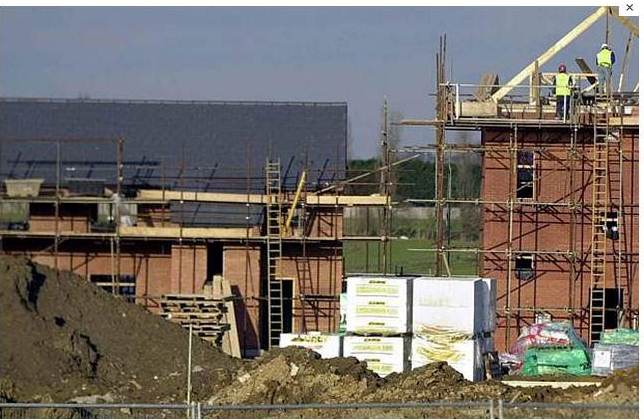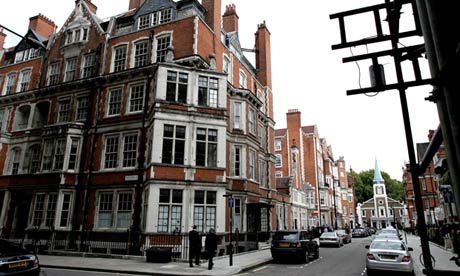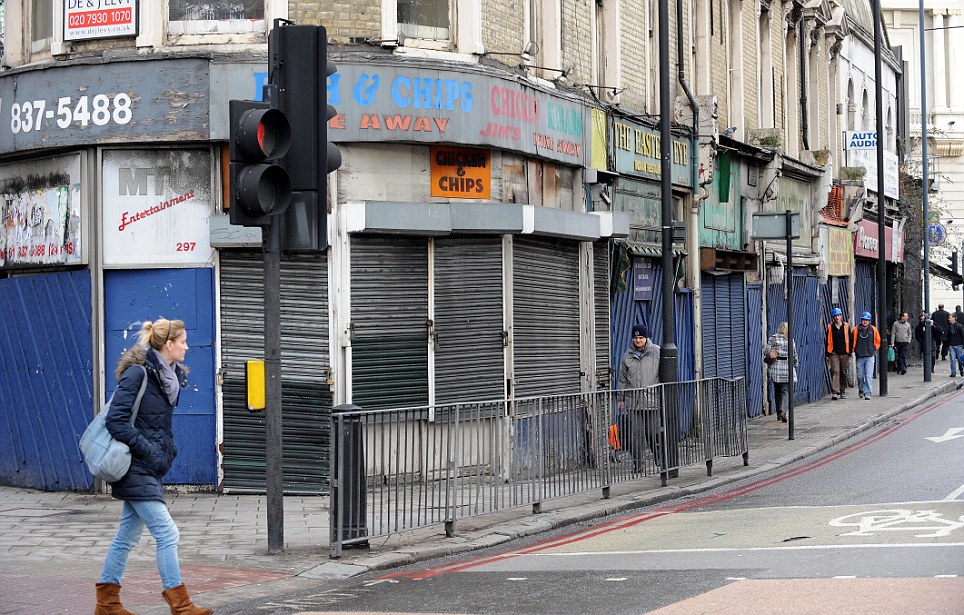464: Demographics and Retail Decline and the Conversion of Properties Above Shops to Flats
03-29-2013
PropertyInvesting.net team
Population Boom – But Where’s The Building Boom?
Population Boom: The UK is experiencing an unprecedented population boom – particularly in the south-east. This is partly because the fertility rate has increased, and partly because inward migration exceeding outward migration. Furthermore, families that have migrated inwards have tended to have more kids than indigenous families. As the make-up of the UK population has changed in cities across the UK - the population has increased.
Building Bust: Set this against the lowest levels of home building at any time since 1916 World War I. It has become increasingly difficult to build homes because:

· There is so little low cost land available
· There is almost no greenfield land available
· Building materials, energy and labour costs have sky-rocketted in the past 10 years
· It is very difficult to get bank funding for building – in part because of the near bankruptcy of building companies after the property boom went bust in 2008 and also because of the weakness of zombie bailed-out banks
· The demand for new build properties remains quite low in large part because banks demand deposits of 20+% (rather than 5% common in 2007)
· First time buyers are few and far between – in part because they are paying back student loans (~£50,000) and wedding costs (~£20,000). Their disposable income whilst inflation ravages is close to zero and their living standards have often in decline
· Builders and developers are reluctant to take any risks because of the stagnant UK economy, pessimism and depressing economic outlook – investors are also reluctant to support building
· Massive new regulations, many from the EU, such as affordable housing allocations, environmental standards, energy efficiency standards, contributions to sewerage, water, electricity-gas, roads, schools etc – have put builders off - cost risks are too high
Housing Crisis: The housing crisis therefore rumbles onwards. Chancellor Osborne’s recent help for first time buyers is likely to help some people get on the property market - even purchase homes up to £600,000, but not help create much home building – it’s likely to increase demand for property, reduce rental demand but not create much new supply – whilst driving up the price of existing second hand properties. The reason for flagging this, is to describe this continuing trend – it will certainly be good for increasing house prices and rental prices – regrettably the housing crisis is set to continue. Too many layers of regulation, planning, stakeholders and lack of incentive to take risks has led to this massive housing crisis. It really looks likely to worsen over the years rather than improve. The UK is creating 110,000 new properties a year, but it really needs about 230,000 a year. This deficit of >100,000 properties a year has continued since before the millennium. Just don’t expect this gap to close. The supply deficit will continue. The scene is set for another ten years of low home building levels and increasing strains on the aging existing housing stock. A bleak picture, though for property investors with large existing property portfolios, you will see prices rise above trend as the squeeze continues – particularly in London and the SE. If you look where the most high paid jobs are being created, along with very little building – you will get the highest house price rises. London is tops – particularly Central London, West End, or anywhere within ½ mile of the Thames – five miles up and down the river from Charing Cross in central London. This will be the focus of the jobs boom where very little building and massively increasing population will drive prices even higher.
supply – whilst driving up the price of existing second hand properties. The reason for flagging this, is to describe this continuing trend – it will certainly be good for increasing house prices and rental prices – regrettably the housing crisis is set to continue. Too many layers of regulation, planning, stakeholders and lack of incentive to take risks has led to this massive housing crisis. It really looks likely to worsen over the years rather than improve. The UK is creating 110,000 new properties a year, but it really needs about 230,000 a year. This deficit of >100,000 properties a year has continued since before the millennium. Just don’t expect this gap to close. The supply deficit will continue. The scene is set for another ten years of low home building levels and increasing strains on the aging existing housing stock. A bleak picture, though for property investors with large existing property portfolios, you will see prices rise above trend as the squeeze continues – particularly in London and the SE. If you look where the most high paid jobs are being created, along with very little building – you will get the highest house price rises. London is tops – particularly Central London, West End, or anywhere within ½ mile of the Thames – five miles up and down the river from Charing Cross in central London. This will be the focus of the jobs boom where very little building and massively increasing population will drive prices even higher.
Conversion of Properties Above Shops to Flats
Retail Decline: One of the key socio-economic trends in the UK at present is the dec line in retail – particularly in average and peripheral retail areas in cities, towns and villages across the UK. Towns in rural areas have been particularly badly hit. The reasons are the increasing usage of out of town retail parks, increasing internet shopping, an aging babyboomer population that spends less, higher rates, greater regulatory burden, and the general stagflation of the economic environment. Hard pressed councils have increased tax and rates to pay for their bloated public sector employee salaries – new regulations have made it harder for small retails stores to survive and vast swathes of retail shopping areas have become boarded up – or given over to charities for charity shops. It’s a desperate state of affairs that will not get better any time soon in areas well away from London. Meanwhile – the population continues to expand, and the amount of poorer people needing to rent also expands. Rental prices have risen. Rental property is in short supply in most areas. Levels of building are almost zero. Onerous and costly regulations and slow planning processes have stopped almost all building – along with the difficultly in getting bank funding and risks of building. There is a housing crisis that stretches back years – caused in part by the inefficient regulated environment that makes everything too costly – plus high inflation rates that has driven up building and labour costs to prohibitive levels.
line in retail – particularly in average and peripheral retail areas in cities, towns and villages across the UK. Towns in rural areas have been particularly badly hit. The reasons are the increasing usage of out of town retail parks, increasing internet shopping, an aging babyboomer population that spends less, higher rates, greater regulatory burden, and the general stagflation of the economic environment. Hard pressed councils have increased tax and rates to pay for their bloated public sector employee salaries – new regulations have made it harder for small retails stores to survive and vast swathes of retail shopping areas have become boarded up – or given over to charities for charity shops. It’s a desperate state of affairs that will not get better any time soon in areas well away from London. Meanwhile – the population continues to expand, and the amount of poorer people needing to rent also expands. Rental prices have risen. Rental property is in short supply in most areas. Levels of building are almost zero. Onerous and costly regulations and slow planning processes have stopped almost all building – along with the difficultly in getting bank funding and risks of building. There is a housing crisis that stretches back years – caused in part by the inefficient regulated environment that makes everything too costly – plus high inflation rates that has driven up building and labour costs to prohibitive levels.
Regulations and Hassles: For the property investors, it’s become more difficult over the years to eke out high returns – risks have risen, and hassles and threats from regulators have driven many investors away. Threat of control orders and even prosecution for things that are not a landlords responsibility (e.g. tenant’s dumped rubbish) means many people with excellent reputations simply feel they cannot afford to have their names tarnished by heavy handed regulators. They sell up. 
Opportunities: This leads us onto the business opportunity – for hard working industrious landlords. There are huge numbers of empty properties above retail-commercial premises – that would make excellent high yield rental properties. This is not for the faint hearted. This business is only for the robust landlord that is organised, hard-working, and can work well with regulators.
Finding: The first step is to identify a number of empty properties above shops. You can post letters through their letter box – see who owns the commercial lease. Or find out through the land registry office who owns the property. Or contact estate agents – ask them openly what you are looking for. These distressed commercial landlords will probably be only too happy to bail out at a reasonable price. If you walk or drive along any high street in your local town or city, you will see vast swathes of such properties standing idle.
Approaching: Once you have a number of these properties logging, you should then ide ntify a few examples. Then contact the planning office – to see what they think about your chances of achieving "change of use" planning permission - from commercial to residential - to convert the properties into flats. If the property is over three floors, be careful since the top floor means it will then register as Home of Multiple Occupancy even if they are separate flats - the fire regulations are quite stringent for three story residential properties. It will need a linked fire alarm system throughout linking each flat.
ntify a few examples. Then contact the planning office – to see what they think about your chances of achieving "change of use" planning permission - from commercial to residential - to convert the properties into flats. If the property is over three floors, be careful since the top floor means it will then register as Home of Multiple Occupancy even if they are separate flats - the fire regulations are quite stringent for three story residential properties. It will need a linked fire alarm system throughout linking each flat.
Planning: If the planning office are supportive and you think the chance of achieving planning consent are very high – we mean 90-95%, then you can put in a very low ball offer for the property. You’ll probably find there is not much competition for such tricky properties.
Acquisition: If you can purchase the three story block for say £130,000, then renovate for about £70,000 – you will have three separate flats worth about £85,000 each – be the freeholder – and have rental income of about £350/month per flat. That’s gross £1050/month. You can then  get the property mortgaged – with low cost mortgage of say 3.5%, with 25% deposit, for say £200,000 and have a very high yield. You will also be providing low cost private rental property and taking an empty home and filling it – thereby helping solve the housing crisis. At any time, you can sell one of the three flats – for say £85,000 each – or rent all three. You can also sell the freehold. You will however have to do the freeholder work – looking after accounts – making the leaseholders aware of any works and quotes – giving adequate notice. Or give this to a property management company for a fee. It also involves organising maintenance work that is the freeholder’s responsibility.
get the property mortgaged – with low cost mortgage of say 3.5%, with 25% deposit, for say £200,000 and have a very high yield. You will also be providing low cost private rental property and taking an empty home and filling it – thereby helping solve the housing crisis. At any time, you can sell one of the three flats – for say £85,000 each – or rent all three. You can also sell the freehold. You will however have to do the freeholder work – looking after accounts – making the leaseholders aware of any works and quotes – giving adequate notice. Or give this to a property management company for a fee. It also involves organising maintenance work that is the freeholder’s responsibility.
Rental Check: Before investing any money, you need to make absolutely sure there is a good rental market for this type of property. Its certainly worth calling letting agents to describe the type of flat, central town location, above a shop, rental price range – to see if they think the private market (non social security tenants) is a good one or not. The last thing you will need is to take losses after investing a large amount of money converting such a property – then find you cannot let the property out.
Niche: Most developers frankly cannot be bothered with such properties. But they are a certain niche – or gap – and if you got particularly good at doing such conversions swiftly and efficiently, it would develop into a nice business with relatively low risks moving forwards as you skills managing such small developments improved.

Upside: If the property has three stories, then HMO regulations apply and you will need to install connected fire alarms between the flats. If the property has a large roof area, then you might find it economic to perform a loft conversion. If the property has a large basement with high ceilings, you could also convert the basement into a flat. If each floor has a large surface area – say 840 square feet, then you could also convert into two studio flats, instead of one or two bedroom flats. They could further increase returns. So if you had a large basement, ground, first and second floors, plus a loft, you might be able to convert into seven flats, valued at say £75,000 each, with rental income potential of about £400/week per unit in an average UK area.
Shifting Trend: Certainly, the planning office and government should look quite favourably on using a disused commercial retail premises on the periphery of a town or city centre for residential use.
We hope this Special Report has given you some good ideas and strategic thoughts to help you with your investment portfolio – and help drive higher returns. If you have any comments, please contact us on enquiries@propertyinvesting.net

